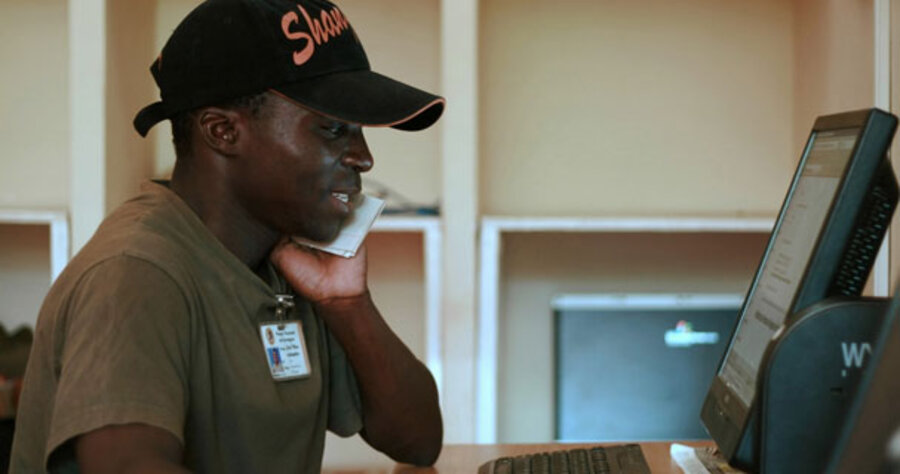African park bridges the ‘Last Mile’ of digital divide
Loading...
| Gorongosa District, Mozambique
José Nhamitambo’s commute starts in the small village called Vinho. He leaves his bamboo and thatch hut, takes a dugout canoe across the coffee-colored Pungue River, and follows a dirt road that cuts through thick, green wilderness. A half mile later he enters the head camp of the Gorongosa National Park, a park that was decimated in Mozambique’s long civil war, and goes to a newly renovated room next to the bombed-out remains of old dormitories.
There, finally, Mr. Nhamitambo gets to check his e-mail.
“It’s very important,” he says, sitting in front of what’s called a “thin client” computer, where four workstations all share a central, low-energy server. “I write documents, I go on the Internet, I write to people who live far from here. Everyone is excited about the computers.”
For years, this impoverished region of central Mozambique has found itself squarely on the losing side of the global digital divide. Most people here lack access to electricity and phone lines, let alone laptops and YouTube. So there was an intense response when three computer labs were built in Gorongosa. The US-based Carr Foundation, which is working to improve conservation and human development around the district, and the United States Agency for International Development (USAID) joined forces to build the labs – part of a global effort to boost information and communication technology in developing countries.
“Many, many people are asking me to teach them,” says Domingos Muala, a language and computer instructor for the Carr Foundation’s project. “Especially the younger generation is interested.... They know that using computers is a big change, it’s a big chance for their lives.”
For decades, Western aid groups have tried to use technology to help impoverished regions. In the 1970s, groups started radio communication initiatives to spread health and other messages. In the 1990s, programs such as the Leland Initiative introduced Internet connectivity to previously wireless African countries.
More recently, USAID funded the Last Mile Initiative – a program to bring innovative technology to areas such as Gorongosa that had been bypassed by the digital revolution.
“When you get into the rural areas of developing countries, you find that parents want three things for their children,” says William Wright, who works for the Carr Foundation and set up Gorongosa’s Last Mile projects. “They want them to learn English. They want them to learn how to drive. And they want them to have computer skills.”
In 2003, the Last Mile Initiative began giving grants – usually about $500,000 and often matched by local businesses or nonprofits – to projects in about 30 countries, says Michael Tetelman of the DOT-COM Alliance in Washington, which helped implement many of the projects.
“With 30 countries you’re showing 30 different business and technology models,” he says. “What’s really been positive is how [the Last Mile Initiative] has shown the vast diversity of models that can be used successfully to provide ICT [information and communication technology.]”
In Kyrgyzstan, for instance, the initiative set up eCenters in rural areas that focused on English-language instruction. In Peru, microtelcos (small-scale phone operators), offer Internet access to farmers. In Macedonia, home of one of the initiative’s largest projects, all elementary and secondary schools have been connected to broadband Internet.
The initiative also worked to tackle regulatory hurdles to reaching underserved communities, Mr. Tetelman says – everything from teleco monopolies to insufficient energy grids.
In Gorongosa, the trick was how to set up computer labs with inconsistent – if any – electricity, in a humid climate all but made for wrecking equipment.
“We wanted to do something creative and cutting edge,” Mr. Wright says. “Desktop computers burn a lot of electricity, so you’re always trying to come up with a way to reduce the load.”
They decided to use the thin-client devices, which are low-energy processors with no cooling fans or other moving parts that could get warped or jammed by the humidity. One laptop acts as a server for the four workstations – a setup that uses far less energy than four full PCs. Meanwhile, the central laptop connects to the Internet using CDMA-EVDO, a broadband wireless technology that is gaining momentum in the US.
In the main park headquarters, a generator powers the lab. In the village of Vinho, the Carr Foundation mounted solar panels on a new elementary school to fuel thin-client devices. (That computer center will open after the village arranges a training and computer initiation program, Nhamitambo and Mr. Muala say.) About 35 miles away, in the town of Gorongosa – the town, park, and district all share the same name – USAID and the Carr Foundation helped open yet another computer center for people living there.
The Last Mile money only covered the computers and some Internet access, Wright says; the community took it from there and organized training sessions and regular computer classes.
Ussene Adjape wants to make sure he gets into the next class. He is a neighbor of Nhamitambo’s and is a carpenter helping with the Carr Foundation’s restoration of the Gorongosa National Park. But he wants to learn on these new computers, he says, so one day he can get a higher level job here – maybe even management. He also expects that his three young sons will get their own e-education in the village.
“We will be able to be successful with computer skills,” he says.
This is the sort of development that was at the root of the Last Mile Initiative, Tetelman says. “I’d like to think we’re working ourselves out of a job,” he says.
The initiative is being phased out this year, with the idea that market forces and local initiative will take over where development left off.
Stephanie Hanes's reporting for this article was partially funded by an Alicia Patterson Foundation fellowship.





